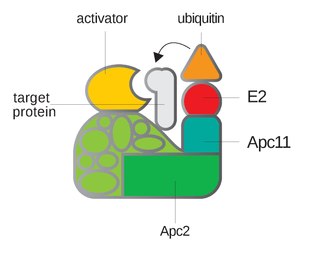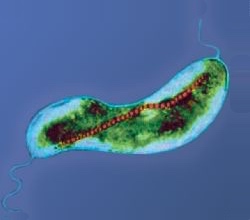External links
- TPR+protein,+human at the US National Library of Medicine Medical Subject Headings (MeSH)
| translocated promoter region (to activated MET oncogene) | |||||||
|---|---|---|---|---|---|---|---|
| Identifiers | |||||||
| Symbol | TPR | ||||||
| NCBI gene | 7175 | ||||||
| HGNC | 12017 | ||||||
| OMIM | 189940 | ||||||
| RefSeq | NM_003292 | ||||||
| UniProt | P12270 | ||||||
| Other data | |||||||
| Locus | Chr. 1 q25 | ||||||
| |||||||
Translocated promoter region is a component of the tpr-met fusion protein.
TPR may refer to:

Vasodilation is the widening of blood vessels. It results from relaxation of smooth muscle cells within the vessel walls, in particular in the large veins, large arteries, and smaller arterioles. The process is the opposite of vasoconstriction, which is the narrowing of blood vessels.

Anaphase-promoting complex is an E3 ubiquitin ligase that marks target cell cycle proteins for degradation by the 26S proteasome. The APC/C is a large complex of 11–13 subunit proteins, including a cullin (Apc2) and RING (Apc11) subunit much like SCF. Other parts of the APC/C have unknown functions but are highly conserved.

Hop, occasionally written HOP, is an abbreviation for Hsp70-Hsp90 Organizing Protein. It functions as a co-chaperone which reversibly links together the protein chaperones Hsp70 and Hsp90.

Magnetotactic bacteria are a polyphyletic group of bacteria that orient themselves along the magnetic field lines of Earth's magnetic field. Discovered in 1963 by Salvatore Bellini and rediscovered in 1975 by Richard Blakemore, this alignment is believed to aid these organisms in reaching regions of optimal oxygen concentration. To perform this task, these bacteria have organelles called magnetosomes that contain magnetic crystals. The biological phenomenon of microorganisms tending to move in response to the environment's magnetic characteristics is known as magnetotaxis. However, this term is misleading in that every other application of the term taxis involves a stimulus-response mechanism. In contrast to the magnetoreception of animals, the bacteria contain fixed magnets that force the bacteria into alignment—even dead cells are dragged into alignment, just like a compass needle.
Co-chaperones are proteins that assist chaperones in protein folding and other functions. Co-chaperones are the non-client binding molecules that assist in protein folding mediated by Hsp70 and Hsp90. They are particularly essential in stimulation of the ATPase activity of these chaperone proteins. There are a great number of different co-chaperones however based on their domain structure most of them fall into two groups: J-domain proteins and tetratricopeptide repeats (TPR).
Tpr-Met fusion protein is an oncogene fusion protein consisting of TPR and MET.

Rotavirus protein NSP3 (NS34) is bound to the 3' end consensus sequence of viral mRNAs in infected cells.

Small glutamine-rich tetratricopeptide repeat-containing protein alpha is a protein that in humans is encoded by the SGTA gene. SGTA orthologs have also been identified in several mammals for which complete genome data are available.

Heat shock 70 kDa protein 14 also known as HSP70-like protein 1 or heat shock protein HSP60 is a protein that in humans is encoded by the HSPA14 gene.

DnaJ homolog subfamily C member 7 is a protein that in humans is encoded by the DNAJC7 gene.

Transmembrane and Tetratricopeptide repeat containing 4 is a protein that in humans is encoded by the TMTC4 gene. This protein crosses the plasma membrane 10 times, and resides in the ER lumen and cytosol. The predicted structure of the TMTC4 protein is a series of alpha-helices.
Reflex bradycardia is a bradycardia in response to the baroreceptor reflex, one of the body's homeostatic mechanisms for preventing abnormal increases in blood pressure. In the presence of high mean arterial pressure, the baroreceptor reflex produces a reflex bradycardia as a method of decreasing blood pressure by decreasing cardiac output.

The tetratricopeptide repeat (TPR) is a structural motif. It consists of a degenerate 34 amino acid tandem repeat identified in a wide variety of proteins. It is found in tandem arrays of 3–16 motifs, which form scaffolds to mediate protein–protein interactions and often the assembly of multiprotein complexes. These alpha-helix pair repeats usually fold together to produce a single, linear solenoid domain called a TPR domain. Proteins with such domains include the anaphase-promoting complex (APC) subunits cdc16, cdc23 and cdc27, the NADPH oxidase subunit p67-phox, hsp90-binding immunophilins, transcription factors, the protein kinase R (PKR), the major receptor for peroxisomal matrix protein import PEX5, protein arginine methyltransferase 9 (PRMT9), and mitochondrial import proteins.
In molecular biology, the BEN domain is a protein domain which is found in diverse proteins including:
In molecular biology, the BtpA protein family is a family of proteins which includes BtpA. BtpA appears to play a role in the stabilisation of photosystem I. It is an extrinsic membrane protein located on the cytoplasmic side of the thylakoid membrane. Homologs of BtpA are found in the crenarchaeota and euryarchaeota, where their function remains unknown. The Ycf4 protein is firmly associated with the thylakoid membrane, presumably through a transmembrane domain. Ycf4 co-fractionates with a protein complex larger than PSI upon sucrose density gradient centrifugation of solubilised thylakoids. The Ycf3 protein is loosely associated with the thylakoid membrane and can be released from the membrane with sodium carbonate. This suggests that Ycf3 is not part of a stable complex and that it probably interacts transiently with its partners. Ycf3 contains a number of tetratricopeptide repeats (TPR); TPR is a structural motif present in a wide range of proteins, which mediates protein-protein interactions.

Protein O-GlcNAc transferase also known as OGT is an enzyme that in humans is encoded by the OGT gene. OGT catalyzes the addition of the O-GlcNAc post-translational modification to proteins.

Tetratricopeptide repeat protein 39B is a protein that in humans is encoded by the TTC39B gene. TTC39B is also known as C9orf52 or FLJ33868. The main feature within tetratricopeptide repeat 39B is the domain of unknown function 3808 (DUF3808), spanning the majority of the protein.
IFIT proteins are produced in the human body and are supposed to confer immunity against viral infection. These proteins are generally produced during viral infection; Interferon (IFN) treatment; and during pathogen recognition by the immune system during infections.

Tetratricopeptide repeat domain 16 (TTC16) is an uncharacterized protein that in humans is encoded by the gene TTC16. Another alias for this gene is TPR repeat protein 16, but this is not commonly used. TTC16 is one of many proteins that contain tetratricopeptide repeat motifs as a supersecondary structure.